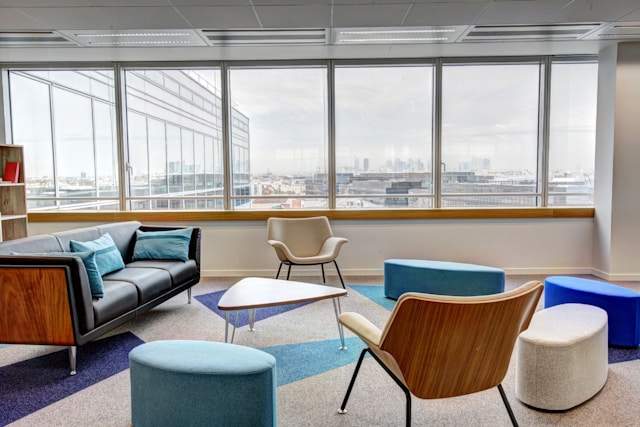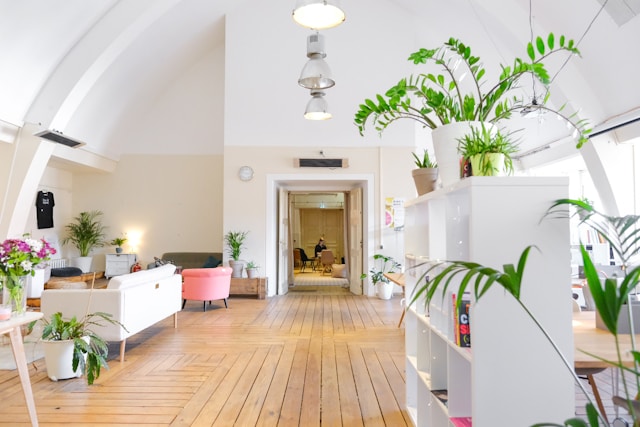

Is your workplace healthy? How can you tell? It’s often not an on-site gym or salad bar but the invisible factors determining how health-conscious an office space is.
Tiny details you might not consciously notice can influence overall productivity and even your attitude toward work. If morale in your workspace seems low, investigating these six areas could reveal why your staff feels vaguely under the weather.
1. Lighting
Did you know that fluorescent lights contain invisible pulsing? You may not notice it, but one in seven employees with migraines does. Anyone who has ever been sick knows what pain does to your productivity.
Natural light is best, as 70% of workers report increased work output as a direct result of sunlight exposure. However, not every office space has oodles of windows and skylights. Your next best bet is soft LEDs, preferably with soothing green or blue undertones, as many find such hues relaxing and conducive to focus. Light bars, floor and desk lamps let you project illumination where you need it.
2. Flooring And Sound Considerations
Imagine the clamor of 30 pairs of high heels clacking across a concrete floor encased by a metal warehouse. Merely thinking about it makes you cover your ears. Offices can get noisy with competing phone conversations and meetings combined with poor acoustics.
Carpets can harbor nasty germs but are less problematic in workspaces than in homes with crawling babies. A drop ceiling with acoustic tiles can cut the warehouse echo. Allowing employees to wear headphones — or at least a single earbud — can also boost productivity. Many neurodiverse individuals find these devices help them focus and decrease anxiety.
3. Fresh Air
The COVID-19 pandemic drove home how crucial it is to maintain the HVAC system in your workplace. Additionally, Americans lose 3.5 million workdays each year due to allergies, sometimes indistinguishable from colds. Change filters and use windows to provide light and ventilation. Choose an opening model over a fixed pane if it’s time for a replacement.
Copious studies show the healing power of the outdoors, but how can workers harness it when they labor from sunup to sundown? Provide a pleasant outdoor seating area — perhaps on a green roof in urban areas — so staff can stretch their legs in the fresh air.

4. Break Room Design
Your outdoor space can double as a secondary break room, especially if you add a few heaters and umbrellas for summer shade. Nearly every office space has a snack machine — but you typically exercise some control over what’s inside. Can you add dried fruit slices, jerky, cheese sticks and veggies among the chips and candy bars?
Coffee is already chock-full of antioxidants that may combat cognitive decline and even cancer. However, adding a few herbal teas is a nice touch. Staff can add a bit of healing turmeric and ginger to their java or calm down after a tough meeting by sipping lavender and chamomile.
5. Seating
Poor seating contributes to chronic back pain, which leads to more frequent sick days. It costs relatively little to provide all staff members with properly fitted office chairs.
However, one-size-fits-all is seldom the right solution. Some workers may prefer a variable-height desk to transition from sitting to standing throughout the day. Others may want to occasionally swap their office chair for an inflatable fitness ball. Surveying your staff or letting them try different chairs on for size shows you care about their wellbeing.
6. A People-First Mindset
What is “work?” How will you know when you have finished everything, and where do you jet off to afterward? Mars? The reality is that work, paid or unpaid, will always be a part of life. Furthermore, life is what you make of it, and what makes it worth living is pleasant times with good people.
The healthiest office spaces recognize this reality and put people ahead of productivity demands. That doesn’t mean paying people to slack, but, in the words of executive coach Sam Adeyemi, “caring about the person before the task.” It goes beyond not firing someone for calling out to tend to a sick child and digging deeper. For example, if an employee isn’t producing, it prompts a gentle inquiry as to why and what support they may need to thrive.
Ironically, such workplaces tend to get more done. Happy workers are less likely to jump ship, and having a consistent team year after year produces dividends far beyond what an overbearing manager cracking a metrics whip can do with a revolving-door crew. Additionally, staff members who feel supported call out less often and are more likely to step up to the plate during legitimate crunch times with minimal grumbling, knowing they’ll get a breather later.
Invisible Office Space Health Factors
Your office might look healthy enough on the surface, but frequent sick days raise questions. These invisible factors can take a toll on productivity. Improving the overall wellness of your facility by taking appropriate steps makes your business a place where people want to work.
 Author Bio
Author Bio
Oscar Collins is the editor-in-chief at Modded, where he writes about health and fitness. Follow him on Twitter @TModded for regular updates on his work, and subscribe to Modded Minute for more!
